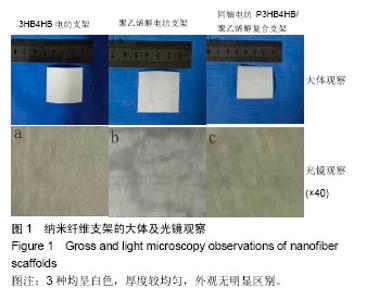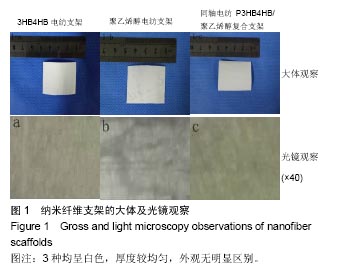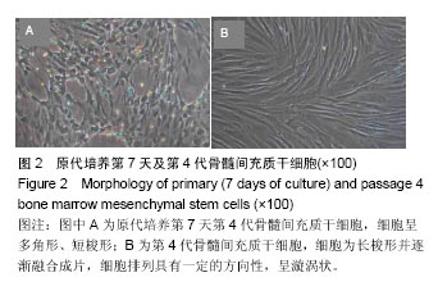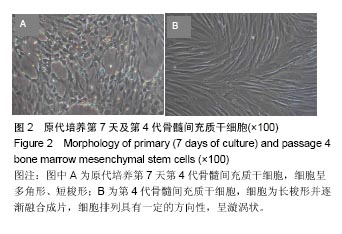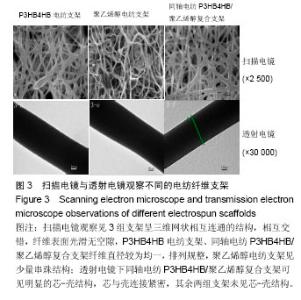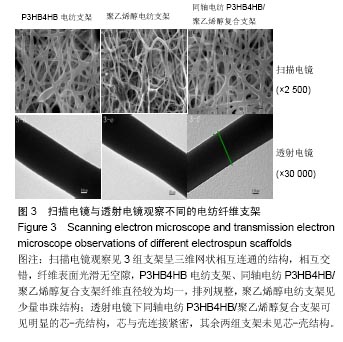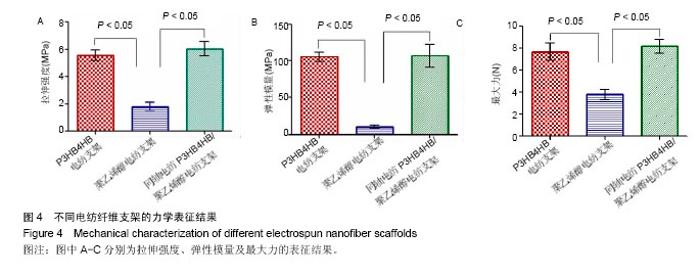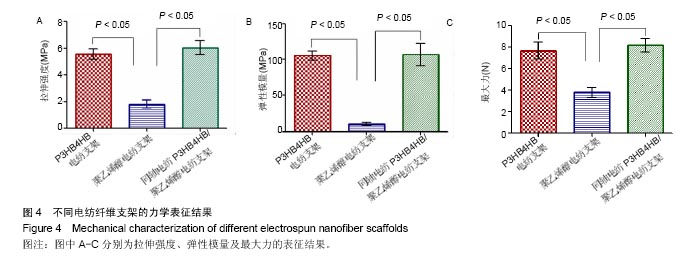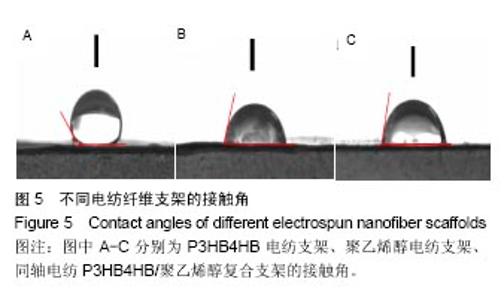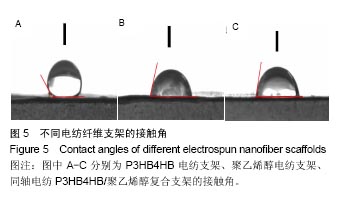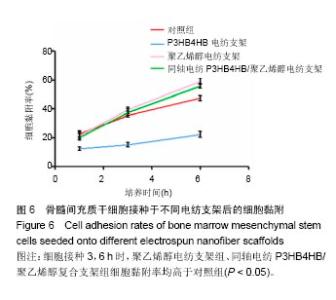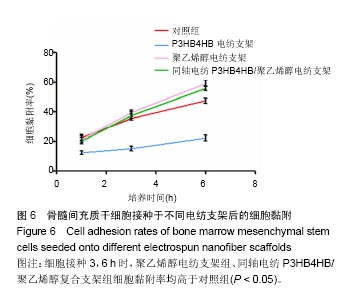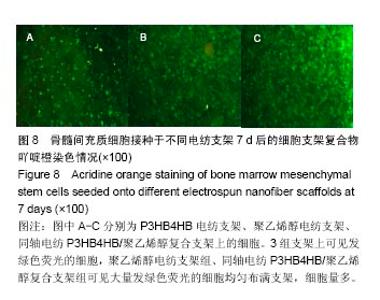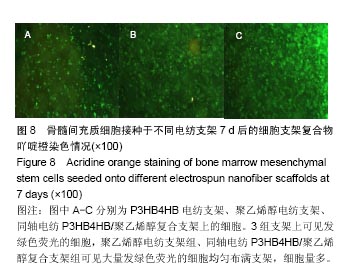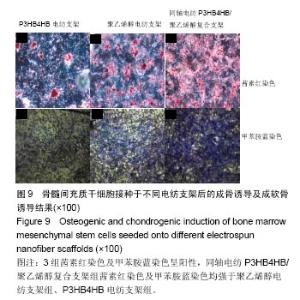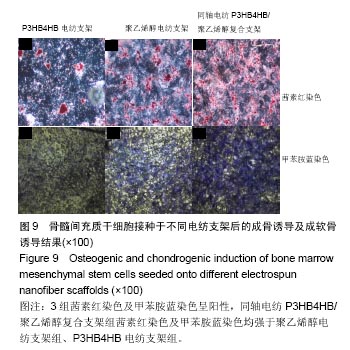Chinese Journal of Tissue Engineering Research ›› 2018, Vol. 22 ›› Issue (2): 234-240.doi: 10.3969/j.issn.2095-4344.0012
Previous Articles Next Articles
Preparation of a poly(3-hydroxybutyrate-4-hydroxybutyrate)/polyvinyl alcohol composite scaffold by coaxial electrospinning and its biocompatibility
- 1Guizhou Medical University, Guiyang 550004, Guizhou Province, China; 2Department of Stomatology, Affiliated Hospital of Guizhou Medical University, Guiyang 550004, Guizhou Province, China; 3National and Guizhou Joint Engineering Laboratory for Cell Engineering and Biomedicine Technique, Guizhou Medical University, Guiyang 550004, Guizhou Province, China; 4Department of Orthopedics, Affiliated Hospital of Guizhou Medical University, Guiyang 550004, Guizhou Province, China; 5Guiyang Stomatological Hospital, Guiyang 550002, Guizhou Province, China
-
Received:2017-08-30Online:2018-01-18Published:2018-01-18 -
Contact:Ma Min-xian, Associate chief physician, Guizhou Medical University, Guiyang 550004, Guizhou Province, China; Department of Stomatology, Affiliated Hospital of Guizhou Medical University, Guiyang 550004, Guizhou Province, -
About author:Liu Qin, Studying for master’s degree, Guizhou Medical University, Guiyang 550004, Guizhou Province, China; Department of Stomatology, Affiliated Hospital of Guizhou Medical University, Guiyang 550004, Guizhou Province, China; National and Guizhou Joint Engineering Laboratory for Cell Engineering and Biomedicine Technique, Guizhou Medical University, Guiyang 550004, Guizhou Province, China -
Supported by:the National Natural Science Foundation of China, No. 81360232; the Science and Technology Program Project of Guiyang, No. 20141001
CLC Number:
Cite this article
Liu Qin, Ye Chuan, Zhang Jun-biao, He Zhi-xu, Cui Dong-bing, Yang Yan, Li Jing, Zhu Ting-ting, Chen Jiao, Ma Min-xian.
share this article
Add to citation manager EndNote|Reference Manager|ProCite|BibTeX|RefWorks
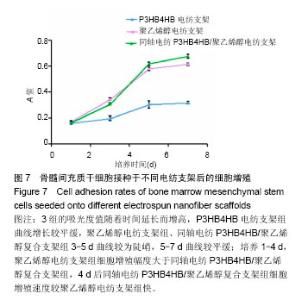
2.2.2 细胞增殖实验 3组的吸光度值随着时间延长而增高,P3HB4HB电纺支架组曲线增长较平缓,聚乙烯醇电纺支架组、同轴电纺P3HB4HB/聚乙烯醇复合支架组3-5 d曲线较为陡峭,5-7 d曲线较平缓;培养1-4 d,聚乙烯醇电纺支架组细胞增殖幅度大于同轴电纺P3HB4HB/聚乙烯醇复合支架组,4 d后同轴电纺P3HB4HB/聚乙烯醇复合支架组细胞增殖速度较聚乙烯醇电纺支架组快(图7)。进一步两两比较结果显示培养3,5,7 d时,P3HB4HB电纺支架组与聚乙烯醇电纺支架组、同轴电纺P3HB4HB/聚乙烯醇复合支架组细胞增殖比较差异有显著性意义(P < 0.05),但聚乙烯醇电纺支架组与同轴电纺P3HB4HB/聚乙烯醇复合支架组比较差异无显著性意义(P > 0.05)。"

| [1]Li Y,George AT,Chen QZ.Novel elastomeric fibrous networks produced from poly(xylitol sebacate)2:5 by core/shell electrospinning:Fabrication and mechanical properties.J Mech Behav Biomed Mater. 2014;40:210-221.[2]Liu HQ,Yu XL,Cai B,et al.Capture and release of cancer cells using electrospun etchable MnO2 nanofibers integrated in microchannels. Appl Phys Lett.2015;106:1-5.[3]杨锦秀,何乐人.小口径电纺组织工程血管支架的研究进展[J].组织工程与重建外科杂志,2016,12(3):191-194.[4]Xue JJ,He M,Liu H,et al.Drug loaded homogeneous electrospun PCL/ gelatin hybrid nanofiber structures for anti-infective tissue regeneration membranes.Bilmaterials. 2014;35:9395-9405.[5]Mojtaba Koosha,Hamid Mirzadeh.Electrospinning,mechanical properties,and cell behaviorstudy of chitosan/PVA nanofibers.J Biomed Mater Res A.2015;103:3081-3093.[6]Li DW,Chen WM,Sun BB,et al.A comparison of nanoscale and multiscale PCL/gelatin scaffolds prepared by disc-electrospinning.Colloids Surf B Biointerfaces. 2016;146: 632-641.[7]Hasan A,Memic A,Annabi N,et al.Electrospun scaffolds for tissue engine-ering of vascular grafts.Acta Biomaterialia. 2014;10:11-25.[8]李耀华.大块血管化组织工程骨修复的骨缺损[J].中国组织工程研究,2014,18(7):991-996.[9]Ji J,Benny BO,H.Wagner HD.Mechanics of electrospun collagen and hydroxyapatite/collagen nanofibers.J Mech Behav Biomed Mater.2012;13:185-193.[10]Rezaei B,Ghani M,Askari M,et al.Fabrication of thermal intelligent core/shell nanofibers by the solution coaxial electrospinning process.Adv Polym Technol. 2016;35(1):21534.[11]Kaerkitcha N,Chuangchote S,Sagawa T.Control of physical properties of carbon nanofibers obtained from coaxial electrospinning of PMMA and PAN with adjustable inner/outer nozzle-ends.Nanoscale Res Lett.2016;11(1):186.[12]牛红星,穆军升,张健群,等.骨髓间充质干细胞与聚3-羟基丁酸酯-co-4-羟基丁酸酯生物材料共培养细胞补片的初步研究[J].中国生物工程杂志, 2012,32(10):74-79.[13]高兆营,马莹,刘慧芳,等.生物降解聚(3-羟基丁酸-co-4-羟基丁酸酯)改性研究进展[J].工程塑料应用,2015,43(12):127-131.[14]Chen DZ,Chen Y,Ouyang X,et al.Influence of microPCMs on thermal and dynamic mechanical properties of a biodegradable P3HB4HB composite.Composites:Part B. 2014;56:245-258.[15]许菡,孔梅梅,安军,等.生物可降解高聚物P3HB4HB热性能、结晶性能和力学性能研究[J].离子交换与吸附,2012,28(5):385-392.[16]侯俊萍,张丽影,赵小菁,等.环氧乙烯基笼型倍伴硅氧烷/ P(3HB-co-4HB)复合材料的制备与降解性能[J].化工新型材料, 2015,43(7):79-81.[17]Li G,Fu N,Xie J,et al. Poly(3-hydroxybutyrate-co-4- hydroxybutyrate) based electrospun 3D scaffolds for delivery of autogeneic chondrocytes and adipose-derived stem cells:evaluation of cartilage defects in rabbit.Biomed Nanotechnol.2015;11:105-116.[18]Ramier J,Boubaker MB,Guerrouache M,et al.Novel routes to epoxy functional ization of PHA-based electrospun scaffolds as ways to improve cell adhesion.J Polym Sci. 2014;52: 816-824.[19]He JX,Tan WL,Han QM,et al.Fabrication of silk fibroin/cellulose whiskers-chitosan composite porous scaffolds by layer-by-layer assembly for application in bone tissue engineering.J Mater Sci.2016;51:4399-4410.[20]杜江,李罡,蓝彩娟,等.聚乙烯醇纳米纤维的制备与静电纺丝工艺研究[J].中外医学研究, 2014,12(8):149-151.[21]Golafshan N,Kharaziha M,Fathi M.Tough and conductive hybrid graphene-PVA: alginate fibrous scaffolds for engineering neural construct.Carbon.2017;111:752-763.[22]Thien DVH,Hsiao SW,Ho MH,et al.Electrospun chitosan/ hydroxyapatite nanofibers for bone tissue engineering.J Mater Sci.2013;48:1640-1645.[23]McClure MJ,Wolfe PS,Rodriguez IA,et al.Bioengineered vascular grafts: improving vascular tissue engineering through scaffold design.J Drug Deliv Sci Technol. 2011;21: 211-227.[24]Fisher MB,Mauck RL.Tissue engineering and regenerative medicine: recent innovations and the transition to translation. Tissue Eng Part B.2013;19:1-13.[25]Gloria A,De SR,Ambrosio L.Polymer-based composite scaffolds for tissue engineering.J Appl Biomater Biomech. 2010;8:57-67.[26]何万林,丁玉梅,马小路,等.熔体法同轴电纺PP/(PLA+PEG)核壳超细纤维[J].工程塑料应用,2016,44(11):48-52.[27]于锐,徐哲伟,穆容超,等.基于不同载药方式的同轴电纺纤维膜的制备与性能[J].合成纤维,2016,45(5):23-27.[28]马敏先,叶川,张俊标,等. P3HB4HB-(GE-PVA)纤维膜载人骨髓间充质干细胞的生物相容性研究[J].贵阳医学院学报, 2016, 41(10):1162-1165.[29]Cho MK,Singu BS,Na YH,et al.Fabrication and characterization of double-network agarose/polyacrylamide nanofibers by electrospinning.J Appl Polym Sci. 2015;133(4): 42914.[30]Ngadiman NHA,Yusof NM,Idris A,et al.Development of highly porous biodegradable γ-Fe2O3/polyvinyl alcohol nanofiber mats using electrospinning process for biomedical application. Mater Sci Eng C.2017; 70:520-534.[31]Ren LF,Xia F,Shao JH,et al.Experimental investigation of the effect of electrospinning parameters on properties of superhydrophobic PDMS/PMMA membrane and its application in membrane distillation.Desalination. 2017; 404:155-166.[32]Santos C,Silva CJ,Büttel Z,et al.Preparation and characterization of polysaccharides/PVA blend nanofibrous membranes by electrospinning method.Carbohydr Polym. 2014;99:584-592.[33]Pangon A,Saesoo S,Saengkrit N,et al.Multicarboxylic acids as environment-friendly solvents and in situ crosslinkers for chitosan/PVA nanofibers with tunable physicochemical properties and biocompatibility.Carbohydr Polym. 2016; 138:156-165.[34]徐方亮,徐影,余灯广.聚合物稀溶液环流同轴电纺制备药物零级控释纳米纤维[J].上海理工大学学报,2015,37(2):165-168.[35]Elsayed Y,Lekakou C,Labeed F,et al.Fabrication and characterisation of biomimetic,electrospun gelatin fibre scaffolds for tunica media-equivalent, tissue engineered vascular grafts.Mater Sci Eng C Mater Biol Appl. 2016;61: 473-483.[36]Semnani D,Naghashzargar E,Hadjianfar M.et al.Evaluation of PCL/chitosan electrospun nanofibers for liver tissue engineering. Int J Polym Mater.2017;66:149-157.[37]李娅莎,刘星,毕杨,等.BMP9诱导人脐带间充质干细胞体内外成骨分化的作用研究[J].中国生物工程杂志,2016,36(5):20-26.[38]赵晓娥,魏强,李伟,等.犬BMSCs干细胞的分离培养及成骨诱导分化[J].农业生物技术学报,2016,24(1):68-75. [39]Zhang ML,Cheng J,Xiao YC,et al.Raloxifene microsphere-embedded collagen/chitosan/b-tricalcium phosphate scaffold for effective bone tissue engineering.Int J Pharm.2017;518:80-85.[40]Wongsupa N,Nuntanaranont T,Kamolmattayakul S,et al.Biological characteristic effects of human dental pulp stem cells on poly-ε-caprolactone-biphasic calcium phosphate fabricated scaffolds using modified melt stretching and multilayer deposition.J Mater Sci Mater Med. 2017;28(2): 25-28.[41]Kargozar S,Lotfibakhshaiesh N,Ai J,et al.Synthesis, physico-chemical and biological characterization of strontium and cobalt substituted bioactive glasses for bone tissue engineering.J Non Cryst Solids.2016;449:133-140. |
| [1] | Pu Rui, Chen Ziyang, Yuan Lingyan. Characteristics and effects of exosomes from different cell sources in cardioprotection [J]. Chinese Journal of Tissue Engineering Research, 2021, 25(在线): 1-. |
| [2] | Lin Qingfan, Xie Yixin, Chen Wanqing, Ye Zhenzhong, Chen Youfang. Human placenta-derived mesenchymal stem cell conditioned medium can upregulate BeWo cell viability and zonula occludens expression under hypoxia [J]. Chinese Journal of Tissue Engineering Research, 2021, 25(在线): 4970-4975. |
| [3] | Zhang Tongtong, Wang Zhonghua, Wen Jie, Song Yuxin, Liu Lin. Application of three-dimensional printing model in surgical resection and reconstruction of cervical tumor [J]. Chinese Journal of Tissue Engineering Research, 2021, 25(9): 1335-1339. |
| [4] | Zhang Xiumei, Zhai Yunkai, Zhao Jie, Zhao Meng. Research hotspots of organoid models in recent 10 years: a search in domestic and foreign databases [J]. Chinese Journal of Tissue Engineering Research, 2021, 25(8): 1249-1255. |
| [5] | Hou Jingying, Yu Menglei, Guo Tianzhu, Long Huibao, Wu Hao. Hypoxia preconditioning promotes bone marrow mesenchymal stem cells survival and vascularization through the activation of HIF-1α/MALAT1/VEGFA pathway [J]. Chinese Journal of Tissue Engineering Research, 2021, 25(7): 985-990. |
| [6] | Shi Yangyang, Qin Yingfei, Wu Fuling, He Xiao, Zhang Xuejing. Pretreatment of placental mesenchymal stem cells to prevent bronchiolitis in mice [J]. Chinese Journal of Tissue Engineering Research, 2021, 25(7): 991-995. |
| [7] | Liang Xueqi, Guo Lijiao, Chen Hejie, Wu Jie, Sun Yaqi, Xing Zhikun, Zou Hailiang, Chen Xueling, Wu Xiangwei. Alveolar echinococcosis protoscolices inhibits the differentiation of bone marrow mesenchymal stem cells into fibroblasts [J]. Chinese Journal of Tissue Engineering Research, 2021, 25(7): 996-1001. |
| [8] | Fan Quanbao, Luo Huina, Wang Bingyun, Chen Shengfeng, Cui Lianxu, Jiang Wenkang, Zhao Mingming, Wang Jingjing, Luo Dongzhang, Chen Zhisheng, Bai Yinshan, Liu Canying, Zhang Hui. Biological characteristics of canine adipose-derived mesenchymal stem cells cultured in hypoxia [J]. Chinese Journal of Tissue Engineering Research, 2021, 25(7): 1002-1007. |
| [9] | Geng Yao, Yin Zhiliang, Li Xingping, Xiao Dongqin, Hou Weiguang. Role of hsa-miRNA-223-3p in regulating osteogenic differentiation of human bone marrow mesenchymal stem cells [J]. Chinese Journal of Tissue Engineering Research, 2021, 25(7): 1008-1013. |
| [10] | Lun Zhigang, Jin Jing, Wang Tianyan, Li Aimin. Effect of peroxiredoxin 6 on proliferation and differentiation of bone marrow mesenchymal stem cells into neural lineage in vitro [J]. Chinese Journal of Tissue Engineering Research, 2021, 25(7): 1014-1018. |
| [11] | Zhu Xuefen, Huang Cheng, Ding Jian, Dai Yongping, Liu Yuanbing, Le Lixiang, Wang Liangliang, Yang Jiandong. Mechanism of bone marrow mesenchymal stem cells differentiation into functional neurons induced by glial cell line derived neurotrophic factor [J]. Chinese Journal of Tissue Engineering Research, 2021, 25(7): 1019-1025. |
| [12] | Duan Liyun, Cao Xiaocang. Human placenta mesenchymal stem cells-derived extracellular vesicles regulate collagen deposition in intestinal mucosa of mice with colitis [J]. Chinese Journal of Tissue Engineering Research, 2021, 25(7): 1026-1031. |
| [13] | Pei Lili, Sun Guicai, Wang Di. Salvianolic acid B inhibits oxidative damage of bone marrow mesenchymal stem cells and promotes differentiation into cardiomyocytes [J]. Chinese Journal of Tissue Engineering Research, 2021, 25(7): 1032-1036. |
| [14] | Guan Qian, Luan Zuo, Ye Dou, Yang Yinxiang, Wang Zhaoyan, Wang Qian, Yao Ruiqin. Morphological changes in human oligodendrocyte progenitor cells during passage [J]. Chinese Journal of Tissue Engineering Research, 2021, 25(7): 1045-1049. |
| [15] | Wang Zhengdong, Huang Na, Chen Jingxian, Zheng Zuobing, Hu Xinyu, Li Mei, Su Xiao, Su Xuesen, Yan Nan. Inhibitory effects of sodium butyrate on microglial activation and expression of inflammatory factors induced by fluorosis [J]. Chinese Journal of Tissue Engineering Research, 2021, 25(7): 1075-1080. |
| Viewed | ||||||
|
Full text |
|
|||||
|
Abstract |
|
|||||
